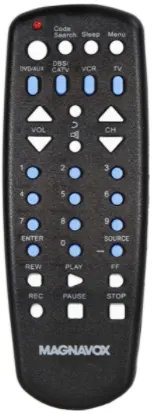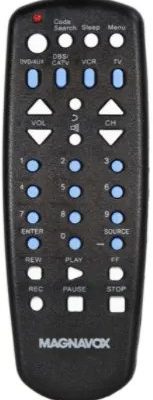
So if the thought of searching for manufacturer codes makes your head spin, or if you’ve lost that little paper years ago (who hasn’t?), you’re not alone. Magnavox’s remotes are actually pretty forgiving. With the right steps, you can get your gadgets and remote to “shake hands” automatically, no code memorization required. Let’s break it down as simply as possible—like chatting with a techie friend who’s been through the remote wars and survived to tell the tale.
What Makes Magnavox Universal Remotes Different?
You might be wondering why people even bother with a universal remote, especially when every TV, DVD, or soundbar usually shows up with its own clicker. The thing is, juggling five remotes isn’t just annoying—it ends up with batteries flying everywhere and remotes lost between couch cushions. Here’s where a Magnavox universal remote steps in, promising to control everything from your ancient VCR to your shiny new smart TV.
What makes Magnavox’s universal remotes interesting isn’t just the brand’s reputation for reliability, but their built-in ability to handle a wild range of device types. They’re designed with a library of codes that speak different “languages” to TVs and gadgets. But—here’s the twist—even if you have no idea what code matches your device, these remotes can kind of “ask around” until they find the right handshake. It’s like speed-dating for electronics, but way less awkward.
Honestly, that’s a lifesaver when you’ve inherited a TV with no manual or you bought some off-brand gadget from a garage sale. If universal remotes were superheroes, Magnavox would be the one with the power to adapt on the fly.
What Is Code Search (Auto-Programming) and How Does It Work?
Let me explain: programming a Magnavox universal remote without code entry is all about something called “code search” or “auto-programming.” Think of it like giving your remote a mission—scan through every code, one by one, until it finds the one that wakes up your device. No guesswork, no code lists, no frantic Googling.
Here’s how it works behind the scenes. When you start the search mode, the remote sends out a series of signals—basically, it’s saying “Are you my device?” over and over. Once your TV or stereo finally “answers” (by turning off, on, or responding), you simply lock that response in by pressing a button. Simple, but kind of genius.
It reminds me of those old radio dials: you didn’t know the exact frequency, but you’d turn the knob slowly until you heard music instead of static. The Magnavox remote does something similar, just at digital speed.
Step-by-Step: Programming Your Magnavox Universal Remote Without Codes
Let’s get practical. You’ve got your Magnavox universal remote and a device that stubbornly ignores it. Forget those intimidating code lists—here are the clear steps to use the auto-programming feature:
- First, make sure your device (TV, DVD player, whatever) is plugged in and turned on. If it’s a TV, set it to a channel with a good signal.
- Now, on your Magnavox remote, press and hold the button for the device you want to control (like “TV” or “AUX”). Keep holding it until the tiny LED light on the remote blinks or stays solid—this tells you you’re in programming mode.
- Next, press and hold the “Power” button while still holding the device button. The LED light should blink or stay on. If not, release and hold both buttons again—sometimes it takes a couple tries (remotes can be moody like that).
- Let go of the “Power” button, but keep holding the device button. Now, tap the “Power” button repeatedly, pausing for a second each time. Watch your device closely—when it turns off, you’ve found the code!
- As soon as your device responds, release all buttons. Quickly press the “Stop” button or whatever button your manual says to save. (Hot tip: If you wait too long, the remote might forget where it was in the scan, and you’ll have to start over. So be ready.)
Pro tip: If your device doesn’t respond after about 100 clicks, take a breath and start again. Sometimes these remotes need a couple cycles to get it right.
Troubleshooting Common Problems
You went through all the steps, but your device still acts like you’re invisible. Frustrating, right? Let’s talk through the most common hiccups and how to get around them.
First, check your batteries. Old or weak batteries can make the remote’s signal too wimpy to get through. I’ve literally wasted hours troubleshooting only to realize it was a pair of almost-dead AAAs. Pop in some fresh ones—seriously, it can work wonders.
Second, make sure there’s nothing blocking the line between remote and device. Sounds basic, but once I realized my cat was sitting in front of the TV sensor. Remote signals are like little flashlights—they need a clear path.
If your Magnavox universal remote just won’t sync, try resetting it. Usually, you can do this by removing the batteries, pressing every button for 3–5 seconds (to drain any leftover juice), popping the batteries back in, and starting from scratch. Yes, it’s tedious, but sometimes remotes just need a clean slate.
Don’t be afraid to run through the auto-programming steps more than once. Sometimes, the first time is just a warm-up round.
Why Use Code Search Instead of Codes?
Maybe you’re thinking, “Why not just type in a code if I can find one?” Good question! Honestly, using the code search method is a lifesaver for a few reasons.
- No Manual Needed: If you’ve lost the instruction booklet (join the club), you’re not stuck.
- Works With Odd Brands: Sometimes your device isn’t listed in the official code list. The auto-search function can still find a code that works—like a detective piecing together clues.
- Perfect for the Forgetful: If you programmed your remote ages ago, then swapped devices, you don’t have to remember which code you used last time. The remote handles the memory work.
There’s also a bit of satisfaction in watching your remote flip through its “rolodex” of codes until it finds the right handshake. Sometimes the classic approach is just more fun (and less stressful).
What If Code Search Doesn’t Work?
Okay, let’s be real—sometimes technology throws a curveball. If the auto-programming didn’t sync your Magnavox remote with your gadget, don’t panic. There are still options, and you’re definitely not doomed to a life of multiple remotes.
- Double-Check Device Compatibility: Magnavox universal remotes work with most devices made in the last 20 years, but very new or super old brands (think vintage or ultra-smart stuff) might not play nicely.
- Try Direct Code Entry: If you managed to dig up the right code, give direct entry another shot—it can sometimes catch what auto-programming misses.
- Consider a Reset: A full reset of the remote can clear up any lingering sync issues. Just remember you’ll have to re-pair everything.
- Upgrade If Needed: Sometimes a newer Magnavox universal remote will support devices the old model can’t. Compare models if you’re dealing with newer tech.
I know it’s tempting to give up and buy a brand-new remote, but usually a little patience (and maybe a snack break) helps you find a fix.
Tips for Getting the Most From Your Magnavox Universal Remote
Once you’ve finally wrangled your Magnavox remote and your device into harmony, keep that peace going. A few habits make a difference:
- Keep the Remote Clean: Crumbs, soda spills, even greasy fingerprints can gum up the works. A gentle wipe-down now and then keeps buttons responsive.
- Store Fresh Batteries Nearby: Weak batteries can mess up the syncing process. I always keep a pair in the kitchen drawer for emergencies.
- Label the Remote: If you’ve got multiple remotes in the house (like for grandma’s TV), a bit of tape with “Living Room” or “Bedroom” scribbled on it can prevent family squabbles and confusion.
- Jot Down What Worked: If you ever do discover a code that works—maybe during a successful code search—make a note and tape it inside the battery cover. Future-you will thank you!
Honestly, a little organization goes a long way with remotes. Who knew they required so much TLC?
Are Universal Remotes Really Better Than Brand-Specific Ones?
Let’s tackle the elephant in the room. Is a universal remote—like the trusty Magnavox—really better than the one that came with your TV or soundbar?
Here’s the thing: it depends on what matters most to you. Brand-specific remotes often offer cool extras, like shortcuts and voice commands. But if you’ve got a Frankenstein’s monster of tech (TV from 2010, soundbar from 2018, DVD player that’s older than your dog), managing all those original remotes is a pain.
A universal remote simplifies life, even if it means giving up a few specialized buttons. Plus, the ability to program it via code search means fewer headaches when you swap or add devices. For most people juggling more than one brand, a Magnavox universal remote strikes the perfect balance between simplicity, flexibility, and just plain convenience.
At the end of the day, a universal remote is a lot like a Swiss Army knife: not always fancy, but ready for almost anything.
Final Thoughts: Bringing Harmony Back to Your Living Room
Programming a Magnavox universal remote without code entry isn’t some mystical skill reserved for tech gurus—it’s totally doable, and honestly, pretty satisfying once you get the hang of it. The code search feature is like a calm, persistent friend who keeps knocking until your device finally answers.
If you hit a snag, remember: fresh batteries, clear paths, and a bit of patience go a long way. And if you ever get nostalgic for the good old days of remote chaos? Well, just peek under your couch cushions—you might find a few “vintage” clickers to remind you how far you’ve come.
Happy syncing! And here’s to never having to argue with your electronics again.
